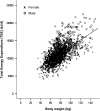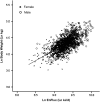Estimating the changes in energy flux that characterize the rise in obesity prevalence
- PMID: 19369382
- PMCID: PMC3738432
- DOI: 10.3945/ajcn.2008.27061
Estimating the changes in energy flux that characterize the rise in obesity prevalence
Abstract
Background: The daily energy imbalance gap associated with the current population weight gain in the obesity epidemic is relatively small. However, the substantially higher body weights of populations that have accumulated over several years are associated with a substantially higher total energy expenditure (TEE) and total energy intake (TEI), or energy flux (EnFlux = TEE = TEI).
Objective: The objective was to develop an equation relating EnFlux to body weight in adults for estimating the rise in EnFlux associated with the obesity epidemic.
Design: Multicenter, cross-sectional data for TEE from doubly labeled water studies in 1399 adults aged 5.9 +/- 18.8 y (mean +/- SD) were analyzed in linear regression models with natural log (ln) weight as the dependent variable and ln EnFlux as the independent variable, adjusted for height, age, and sex. These equations were compared with those for children and applied to population trends in weight gain.
Results: ln EnFlux was positively related to ln weight (beta = 0.71; 95% CI: 0.66, 0.76; R2 = 0.52), adjusted for height, age, and sex. This slope was significantly steeper than that previously described for children (beta = 0.45; 95% CI: 0.38, 0.51).
Conclusions: This relation suggests that substantial increases in TEI have driven the increases in body weight over the past 3 decades. Adults have a higher proportional weight gain than children for the same proportional increase in energy intake, mostly because of a higher fat content of the weight being gained. The obesity epidemic will not be reversed without large reductions in energy intake, increases in physical activity, or both.
Figures





Comment in
-
How large is the energy gap that accounts for the obesity epidemic?Am J Clin Nutr. 2009 Jun;89(6):1717-8. doi: 10.3945/ajcn.2009.27889. Epub 2009 Apr 29. Am J Clin Nutr. 2009. PMID: 19403628 No abstract available.
-
Estimating the quantitative relation between food energy intake and changes in body weight.Am J Clin Nutr. 2010 Mar;91(3):816; author reply 817. doi: 10.3945/ajcn.2009.28922. Epub 2010 Jan 13. Am J Clin Nutr. 2010. PMID: 20071643 Free PMC article. No abstract available.
-
Energy expenditure and the obesity epidemic.Am J Clin Nutr. 2010 Jun;91(6):1801-2; author reply 1802-4. doi: 10.3945/ajcn.2010.29433. Epub 2010 Apr 21. Am J Clin Nutr. 2010. PMID: 20410099 No abstract available.
References
-
- Brown WJ, Williams L, Ford JH, Ball K, Dobson AJ. Identifying the energy gap: magnitude and determinants of 5-year weight gain in midage women. Obes Res 2005;13:1431–41 - PubMed
-
- Haby MM, Vos T, Carter R, et al. A new approach to assessing the health benefit from obesity interventions in children and adolescents: the assessing cost-effectiveness in obesity project. Int J Obes 2006;30:1463–75 - PubMed
-
- Dolan MS, Weiss LA, Lewis RA, Pietrobelli A, Heo M, Faith MS. ‘Take the stairs instead of the escalator’: effect of environmental prompts on community stair use and implications for a national ‘Small Steps’ campaign. Obes Rev 2006;7:25–32 - PubMed
-
- America on the Move. Available from: http://aom.americaonthemove.org (cited September 2008)
-
- Hill JO, Wyatt HR, Reed GW, Peters JC. Obesity and the environment: where do we go from here? Science 2003;299:853–5 - PubMed
Publication types
MeSH terms
Grants and funding
LinkOut - more resources
Full Text Sources
Other Literature Sources
Medical
Miscellaneous

